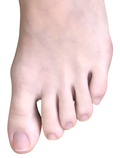Toe
Toe
The toe is one of the five digits located at the end of the human foot. Each toe consists of several bones, the most notable of which are the three phalanges. The toes play a crucial role in maintaining balance, walking, and running.
Anatomy[edit]
Each toe, with the exception of the big toe, has three phalanges: the proximal, middle, and distal. The big toe, or hallux, only has two: the proximal and distal. These bones are connected by joints, which are surrounded by ligaments, tendons, and muscles.
Bones[edit]
The bones of the toes are called phalanges. Each toe, except for the big toe, has three phalanges: a proximal, a middle, and a distal phalanx. The big toe only has a proximal and a distal phalanx.
Muscles[edit]
The toes contain several muscles, which provide the ability to flex, extend, abduct, and adduct the toes. These muscles are divided into two groups: the extrinsic muscles, which originate in the lower leg, and the intrinsic muscles, which originate in the foot.
Function[edit]
The toes play a crucial role in maintaining balance, walking, and running. They provide support and allow for the fine adjustments needed for movement. The big toe, in particular, plays a significant role in propulsion and balance.
Health and disease[edit]
There are many conditions that can affect the toes, including bunions, corns, ingrown toenails, hammer toe, and gout. These conditions can cause pain, difficulty walking, and other complications.
See also[edit]
Ad. Transform your life with W8MD's Budget GLP-1 injections from $75


W8MD offers a medical weight loss program to lose weight in Philadelphia. Our physician-supervised medical weight loss provides:
- Weight loss injections in NYC (generic and brand names):
- Zepbound / Mounjaro, Wegovy / Ozempic, Saxenda
- Most insurances accepted or discounted self-pay rates. We will obtain insurance prior authorizations if needed.
- Generic GLP1 weight loss injections from $75 for the starting dose.
- Also offer prescription weight loss medications including Phentermine, Qsymia, Diethylpropion, Contrave etc.
NYC weight loss doctor appointmentsNYC weight loss doctor appointments
Start your NYC weight loss journey today at our NYC medical weight loss and Philadelphia medical weight loss clinics.
- Call 718-946-5500 to lose weight in NYC or for medical weight loss in Philadelphia 215-676-2334.
- Tags:NYC medical weight loss, Philadelphia lose weight Zepbound NYC, Budget GLP1 weight loss injections, Wegovy Philadelphia, Wegovy NYC, Philadelphia medical weight loss, Brookly weight loss and Wegovy NYC
|
WikiMD's Wellness Encyclopedia |
| Let Food Be Thy Medicine Medicine Thy Food - Hippocrates |
Medical Disclaimer: WikiMD is not a substitute for professional medical advice. The information on WikiMD is provided as an information resource only, may be incorrect, outdated or misleading, and is not to be used or relied on for any diagnostic or treatment purposes. Please consult your health care provider before making any healthcare decisions or for guidance about a specific medical condition. WikiMD expressly disclaims responsibility, and shall have no liability, for any damages, loss, injury, or liability whatsoever suffered as a result of your reliance on the information contained in this site. By visiting this site you agree to the foregoing terms and conditions, which may from time to time be changed or supplemented by WikiMD. If you do not agree to the foregoing terms and conditions, you should not enter or use this site. See full disclaimer.
Credits:Most images are courtesy of Wikimedia commons, and templates, categories Wikipedia, licensed under CC BY SA or similar.
Translate this page: - East Asian
中文,
日本,
한국어,
South Asian
हिन्दी,
தமிழ்,
తెలుగు,
Urdu,
ಕನ್ನಡ,
Southeast Asian
Indonesian,
Vietnamese,
Thai,
မြန်မာဘာသာ,
বাংলা
European
español,
Deutsch,
français,
Greek,
português do Brasil,
polski,
română,
русский,
Nederlands,
norsk,
svenska,
suomi,
Italian
Middle Eastern & African
عربى,
Turkish,
Persian,
Hebrew,
Afrikaans,
isiZulu,
Kiswahili,
Other
Bulgarian,
Hungarian,
Czech,
Swedish,
മലയാളം,
मराठी,
ਪੰਜਾਬੀ,
ગુજરાતી,
Portuguese,
Ukrainian










